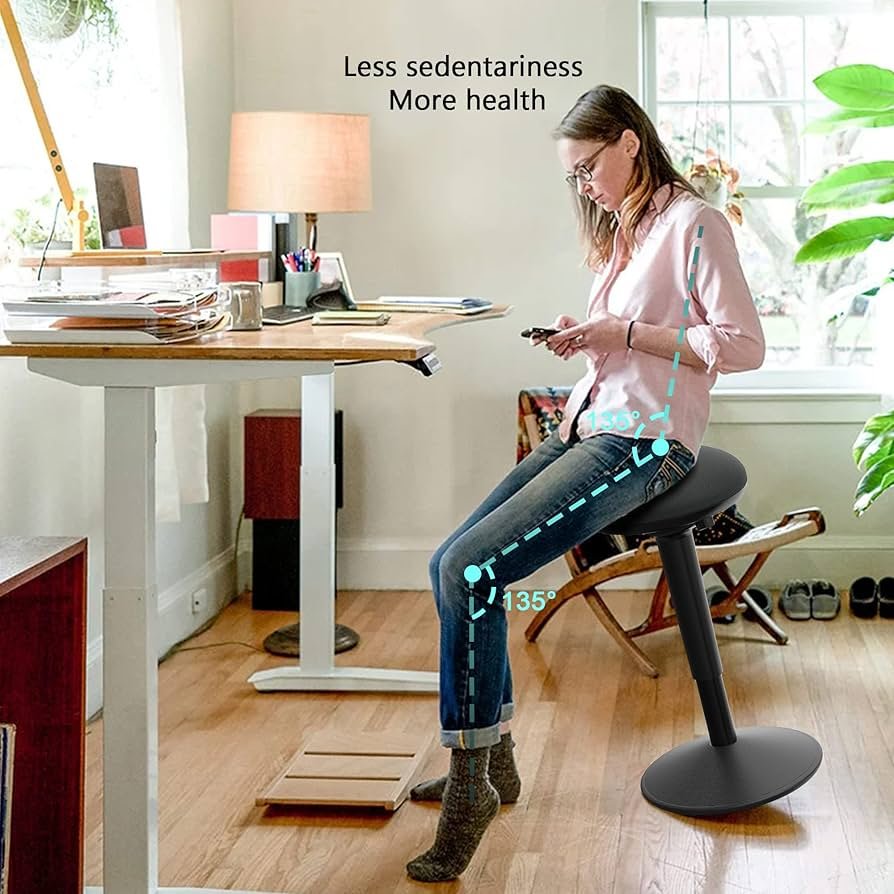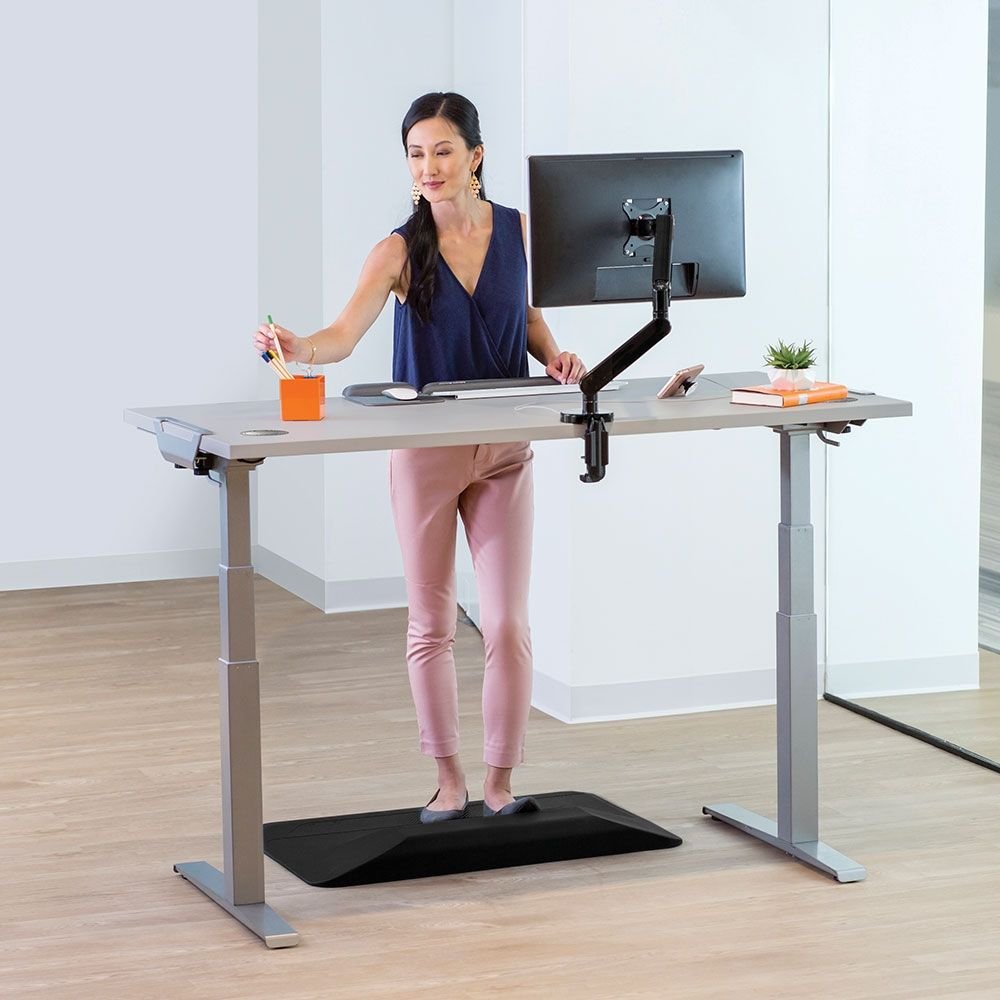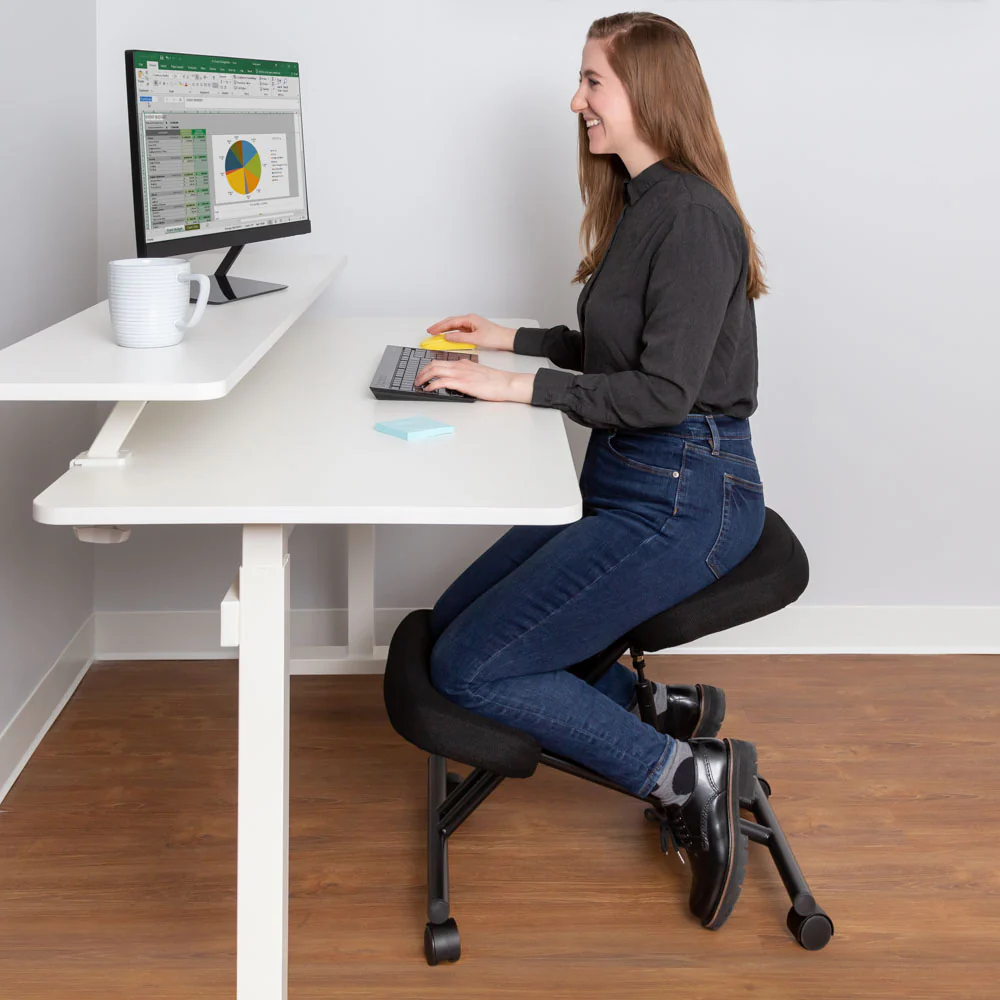Standing desks have emerged as a popular alternative in work environments, offering a solution to the potential health risks associated with prolonged sitting. The conceptualization of these desks can be traced back to notable figures like Leonardo da Vinci, who is said to have used such a desk for his creative pursuits.
However, the modern standing desk, complete with adjustable heights and ergonomic designs, truly gained momentum as a health-conscious trend over the past decade.
The increasing adoption of standing desks is largely driven by growing awareness of the negative health implications of sedentary lifestyles. Numerous studies suggest that extended periods of sitting can contribute to various health issues, including obesity, cardiovascular disease, and even decreased mental wellbeing. This has catalyzed the shift from traditional desks to standing desks, which are perceived as a proactive measure to mitigate these risks.
In contemporary workplaces, standing desks symbolize a step forward in prioritizing employee health and productivity. By facilitating a more dynamic work posture, these desks aim to counteract the drawbacks of continuous sitting.
Additionally, the integration of standing desks aligns with the broader movement towards creating healthier, more adaptable work environments, especially in the context of the growing number of remote and flexible work arrangements.
The trend of using standing desks reflects a significant transformation in how we approach workspaces, emphasizing the importance of both physical health and mental focus. As companies and individuals continue to explore and implement standing desk solutions, their popularity underscores a collective shift towards more conscious and health-oriented working habits.
The Health Risks of Prolonged Sitting
Prolonged sitting has become a significant concern in today’s sedentary lifestyle, where many individuals spend a considerable portion of their day seated. Scientific research has increasingly illustrated the various health risks associated with extended periods of sitting, revealing alarming correlations with several adverse conditions.
Obesity is one of the most commonly cited consequences. The metabolic slowdown that occurs during prolonged sitting can lead to weight gain, as calorie expenditure decreases while fat accumulation increases. Moreover, sitting for extended periods can disrupt the function of lipoprotein lipase, an enzyme that plays a crucial role in breaking down fats within the body, further contributing to weight gain and obesity.
Cardiovascular disease is another major health risk linked with prolonged sitting. Research indicates that sitting for long durations can lead to increased blood pressure, elevated blood sugar levels, and an accumulation of excess body fat around the waist, all of which are risk factors for heart disease. Additionally, the lack of movement reduces blood flow, which can contribute to the development of blood clots and increase the risk of stroke.
Type 2 diabetes has also been connected with prolonged sitting. Inactivity can impair the body’s ability to regulate blood sugar levels, leading to insulin resistance. Studies have shown that individuals who sit for extended periods have a higher likelihood of developing type 2 diabetes compared to those who incorporate more physical activity into their routines.
Given these significant health risks, it is imperative to find alternatives to prolonged sitting. Stand-up desks, for instance, offer a viable solution. By allowing individuals to alternate between sitting and standing, these desks create a more dynamic workspace that encourages movement and helps mitigate the health risks associated with sedentary behavior. Incorporating such alternatives plays a critical role in enhancing overall health and well-being in the modern era.
Benefits of Using a Standing Desk
Standing desks have gained popularity in recent years, and for good reason. One of the primary benefits is improved posture. Traditional sitting for long hours often leads to slouching and poor alignment, which can result in back and neck pain. In contrast, standing desks encourage a more natural position of the spine, promoting better posture and reducing strain on the back and shoulders.
Another significant advantage is the reduction in back pain. A study published in the “Journal of Occupational and Environmental Medicine” found that workers who used standing desks reported a significant reduction in lower back pain compared to their colleagues who remained seated throughout the day. Many users have attested to this benefit, noting a marked decrease in discomfort after switching to a standing desk.
Standing desks can also positively impact energy levels and productivity. A research conducted by the “Texas A&M Health Science Center” revealed that employees who used standing desks experienced lower levels of fatigue and improved concentration. Standing encourages subtle movements and prevents the lethargy associated with prolonged sitting, making individuals feel more alert and engaged.
Additionally, standing while working can contribute to higher productivity. The same study from Texas A&M found that workers using standing desks were 45% more productive on a daily basis. The increase in activity not only keeps the body engaged but also stimulates mental function, fostering a more dynamic and efficient work environment.
These benefits are echoed by countless user testimonials. For instance, one office worker shared that after three months of using a standing desk, they experienced less back pain and felt more energized throughout the day. Another user noted an increase in their focus and overall productivity after making the switch.
Incorporating a standing desk into your daily routine may offer substantial health advantages, from better posture and reduced back pain to enhanced energy and productivity. The growing body of evidence and positive user experiences make a compelling case for considering this ergonomic alternative to traditional seated desks.
The rising popularity of standing desks brings with it discussions about their potential drawbacks. While standing desks are often lauded for their ergonomic benefits, it is essential to acknowledge the adverse effects that prolonged standing can have on the body. One of the primary concerns is leg and foot pain. Extended periods of standing can put undue stress on the legs, resulting in discomfort, fatigue, and in some cases, more severe musculoskeletal issues.
Another significant risk associated with excessive standing is the development of varicose veins. Standing for long durations can cause blood to pool in the veins of the lower legs, increasing venous pressure and potentially leading to these enlarged, twisted veins. This not only presents a cosmetic concern but can also cause aching, swelling, and a sensation of heaviness, further affecting overall well-being.
There is also the potential for cardiovascular strain when standing desks are used improperly. The act of standing increases the heart’s workload, requiring more effort to pump blood against gravity from the lower extremities back to the heart.
For some individuals, especially those with preexisting cardiovascular conditions, this can exacerbate symptoms and pose health risks. Therefore, it is crucial to balance standing with movement or periods of sitting to mitigate these potential cardiovascular effects.
In summary, while standing desks offer numerous benefits, understanding and mitigating their potential drawbacks is vital. Alternating between sitting and standing, using anti-fatigue mats, and ensuring proper posture can help minimize the adverse impacts.
A holistic approach that incorporates movement throughout the day, rather than prolonged periods of standing, is essential for harnessing the health benefits of standing desks while avoiding potential harms.

Standing Desk Best Practices
To truly reap the health benefits of a standing desk while mitigating potential issues, it’s important to adhere to specific best practices. Proper use of a standing desk involves correct desk height, maintaining good posture, ensuring appropriate foot support, and incorporating regular sitting intervals.
Firstly, the height of the standing desk is crucial. The desk should be set so that your elbows form an approximate 90-degree angle when your arms are at rest and wrists are flat on the surface. The monitor should be at eye level to prevent neck strain. Keeping these adjustments in check promotes a more ergonomic stance, reducing the likelihood of musculoskeletal discomfort.
Posture is another essential element. Ensure your shoulders are relaxed and not hunched while standing. Keep your knees slightly bent, rather than locked, to improve circulation and reduce fatigue. It may also be beneficial to switch your weight from one foot to the other occasionally or use a footrest to vary your position and support your lower back.
Foot support is often overlooked but fundamental for comfort. Wearing supportive footwear and standing on an anti-fatigue mat can help ease pressure on the feet and legs, promoting better overall alignment and reducing strain. Regularly adjusting your standing position also contributes to this, supporting a dynamic stance that fosters movement and better circulation.
Alternating between sitting and standing is imperative to avoid the drawbacks of prolonged standing. Using a sit-stand desk that allows seamless transition between sitting and standing positions is ideal. Aim for a balance, such as 30 minutes of standing followed by 30 minutes of sitting. This variability helps to prevent stiffness and encourages greater overall movement throughout the day, making the standing desk a more healthful tool in your work regimen.
Case Studies and User Experiences
Real-life examples and case studies illustrate the practical effects of using a standing desk, offering valuable insights that go beyond mere theory. Numerous individuals and organizations have integrated standing desks into their daily routines, experiencing both benefits and challenges.
One notable example is a tech startup that transitioned to standing desks to address widespread complaints about back pain. Within six months, employees reported a substantial reduction in discomfort and an overall improvement in posture.
Productivity metrics also improved, with noticeable enhancements in focus and task completion rates. Similarly, a marketing firm observed that team energy levels remained higher throughout the day after incorporating standing desks.
On an individual level, freelance writers and designers have shared their experiences online, often highlighting initial adjustments. Many felt fatigue in the first few weeks but adapted over time. Long-term use resulted in improved health markers such as decreased incidences of muscle strain and better blood circulation.
One freelance graphic designer noted a significant drop in the need for ergonomic accessories like wrist braces after switching to a standing desk.
However, it is essential to mention that the transition to standing desks is not without challenges. A common issue is the initial discomfort experienced when standing for extended periods. Some users have combated this by alternating between sitting and standing, using adjustable desks to adapt their workspace ergonomically. Additionally, anti-fatigue mats have proven helpful in mitigating leg and foot pain.
Organizations such as call centers and administrative departments have found unique ways to promote the use of standing desks. Implementing scheduled standing breaks and creating a culture that encourages movement have been effective strategies.
Employee feedback has generally pointed to higher engagement and satisfaction, attributing these positive changes to the flexibility and health benefits offered by standing desks.
Overall, the practical application of standing desks has shown promising results in improving both health and productivity. While the adjustment period may pose some challenges, the long-term benefits appear to outweigh the initial discomfort, making standing desks a worthy consideration for enhancing workplace well-being.
Comparing Standing Desks with Other Ergonomic Solutions
Standing desks have garnered significant attention as an ergonomic solution aimed at enhancing workplace health and reducing the physical strain associated with prolonged sitting. However, they are just one of numerous tools designed for this purpose.
To provide a comprehensive view, it is essential to compare standing desks with other prevalent ergonomic options such as ergonomic chairs, balance boards, and treadmill desks.
Ergonomic chairs are designed to offer optimal support and comfort while sitting. They aim to reduce back pain and improve posture by offering adjustable features that align with the user’s natural body curves. Unlike standing desks, ergonomic chairs do not require users to alternate between sitting and standing, making them suitable for individuals who prefer or need to sit for extended periods.
Balance boards, often used in conjunction with standing desks, provide a dynamic balance surface that encourages subtle movements. This can improve muscle engagement and stability. While both standing desks and balance boards promote activity, balance boards add an element of core strength training and coordination that standing desks alone do not offer. However, not everyone may find balancing for prolonged periods practical or comfortable.
Treadmill desks represent another innovative approach to integrating activity into the workday. They allow users to walk at a slow pace while performing their tasks. Treadmill desks significantly increase daily physical activity levels and can help counteract the sedentary nature of desk jobs.
However, they may be more costly and occupy more space compared to standing desks. In addition, walking while working might not be suitable for tasks that require high concentration or precision.
Each of these ergonomic solutions has its strengths and may be more suitable depending on individual needs and preferences. Standing desks, ergonomic chairs, balance boards, and treadmill desks all share a common goal of promoting workplace health, yet they offer distinct benefits and potential drawbacks.
Therefore, understanding these differences is crucial for choosing the most appropriate ergonomic tool tailored to one’s personal work environment and health objectives.
Conclusion: Are Standing Desks Right for You?
As we’ve explored, standing desks present a mixed bag of advantages and considerations. On one hand, integrating a standing desk into your daily work routine can combat sedentary lifestyles, potentially reducing the risks associated with prolonged sitting, such as cardiovascular disease and musculoskeletal discomfort. Notably, alternating between sitting and standing may also enhance productivity and alleviate conventional desk-related aches.
However, standing desks aren’t a universal remedy. While some may experience significant health benefits, others might encounter issues such as standing fatigue or lower limb discomfort. Key to reaping the rewards of a standing desk is moderation and proper usage – alternating positions regularly, employing ergonomic setups, and incorporating adequate breaks and stretching exercises.
Investing in a quality anti-fatigue mat and wearing comfortable footwear are also practical steps to support prolonged standing.
Individual preferences and workplace contexts undeniably play vital roles in determining the efficacy of a standing desk. Employees with specific health conditions or unique workflow requirements should consult with healthcare professionals to tailor an optimal working setup. Employers should consider offering flexibility, allowing workers to choose between traditional and standing desks, or even hybrid models that cater to varied needs.
Therefore, the healthiest approach embraces flexibility and individualization. While adopting a standing desk can indeed foster an active work environment and mitigate certain health risks, it requires mindful integration and personal adjustment. Decision-makers are encouraged to weigh the pros and cons carefully, basing their choices on thorough research and personalized needs. Ultimately, the goal is to create a balanced work setting that promotes well-being and accommodates diverse working styles.









